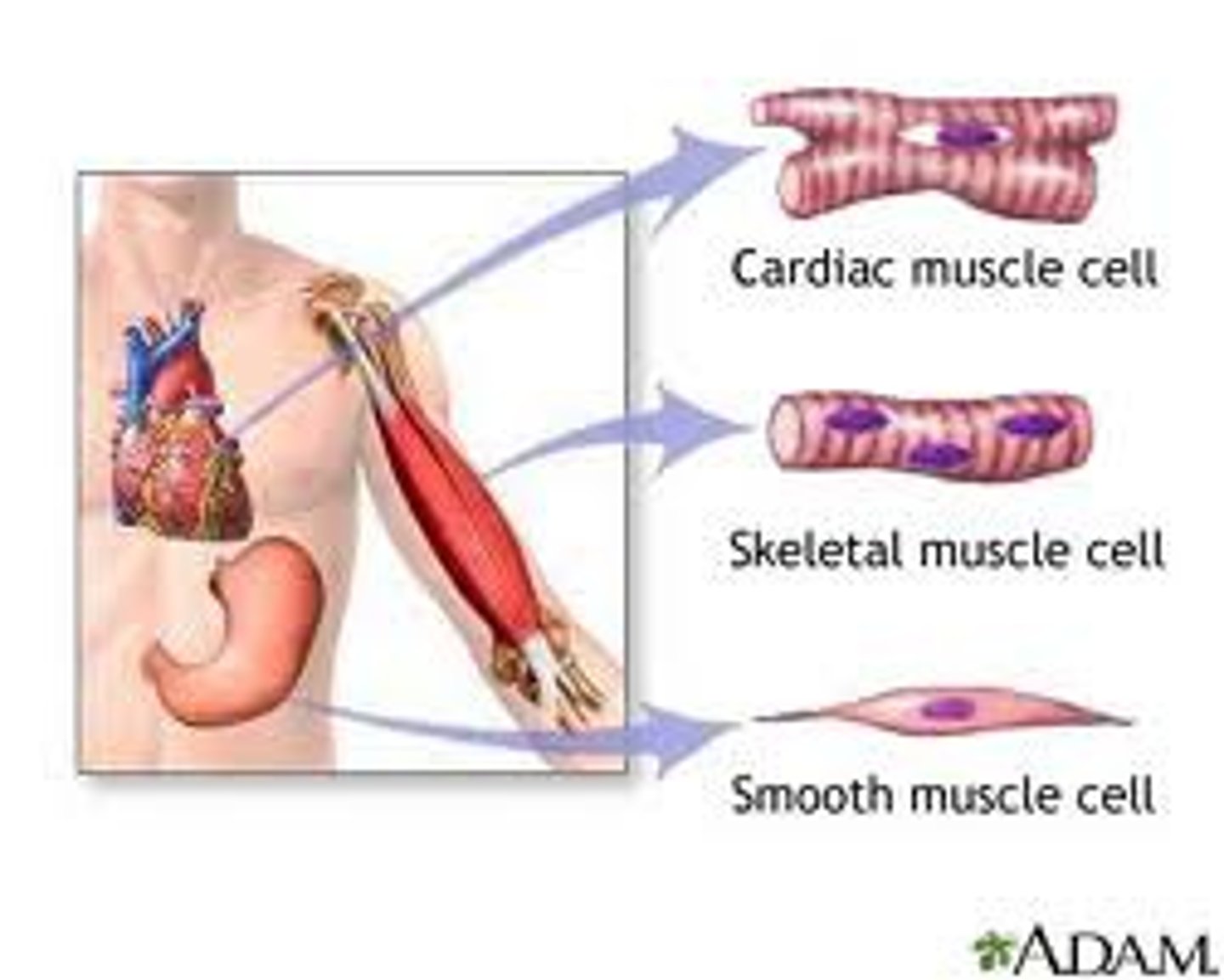APHY 164 - Tissue Types
1/29
There's no tags or description
Looks like no tags are added yet.
Name | Mastery | Learn | Test | Matching | Spaced |
|---|
No study sessions yet.
30 Terms
Epithelial tissue
A basic tissue type that covers the body surface, lines internal cavities and hollow organs, and forms glands; it has the special characteristics of polarity, specialized contacts, avascular, innervated, regeneration, and supported by connective tissue. Also called epithelium.

Connective tissue
A basic tissue type that functions in binding, support, protection, and insulation; composed mainly of nonliving extracellular matrix with relatively few cells.
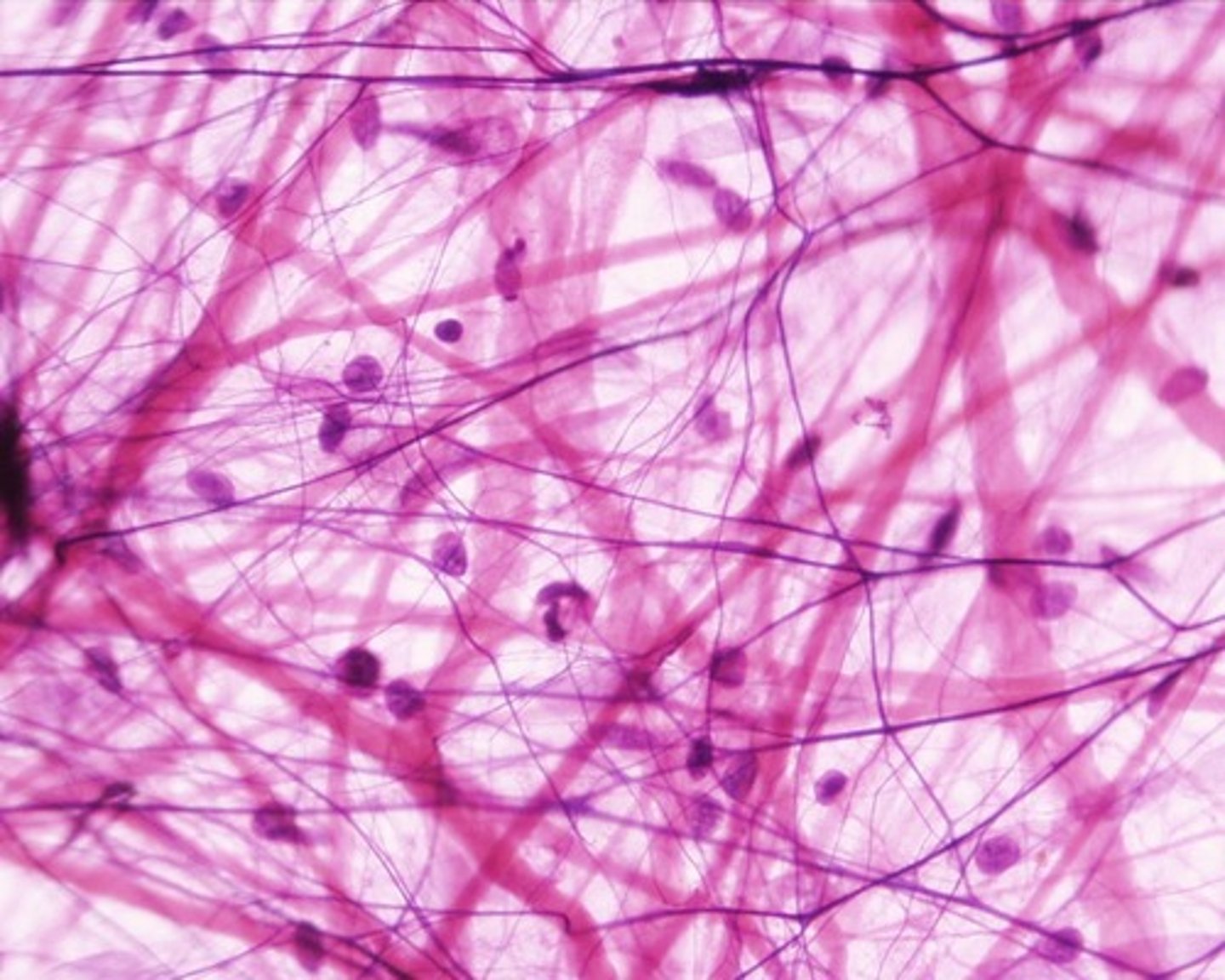
Muscular tissue
A basic tissue type that contracts upon stimulation to produce movement; its three varieties are skeletal, cardiac, and smooth muscle

Nervous tissue
A basic tissue type which contains neurons that initiate and conduct nerve impulses for internal communication and maintainance of homeostasis, and neuroglial cells that support, insulate, and protect the neurons.

Simple Squamous Epithelium
Description: Single layer of flattened cells that have disc-shaped central nuclei and sparse cytoplasm.
Function: Allows rapid diffusion or filtration; secretes serous fluid in serosa.
Location: Lung alveoli; kidney glomeruli; lining of the heart and blood vessels; serous membranes.

Simple Cuboidal Epithelium
Description: Single layer of cubelike cells that have large spherical central nuclei.
Function: Secretion or absorption.
Location: Lines the kidney tubules, small ducts of some glands, and ovary surface
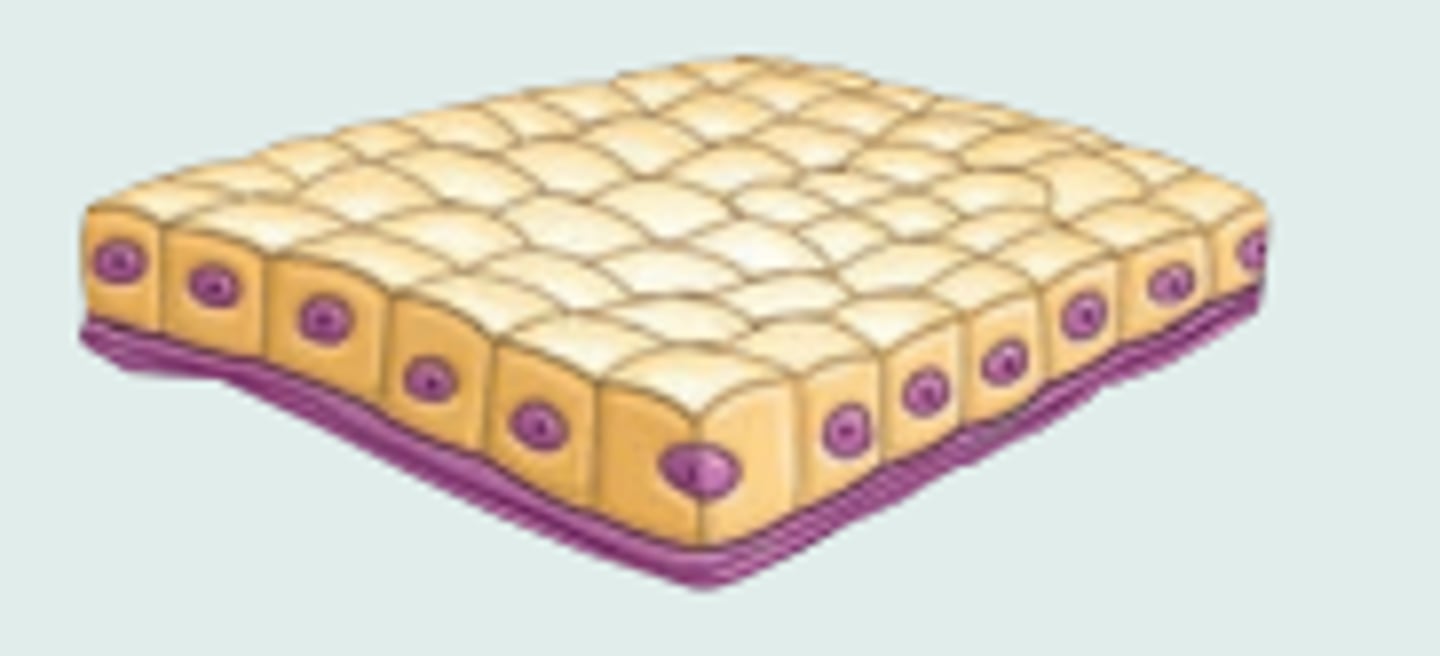
Simple Columnar Epithelium
Description: Single layer of tall cells that have round to oval nuclei; some tissue types contain ciliated cells, others contain microvilli; most tissue types contain mucus-secreting goblet cells (unicellular glands).
Function: Secretion or absorption.
Location: Nonciliated type lines the gastrointestinal tract (stomach to rectum), and ducts of some glands; ciliated type lines small bronchi of the lungs, uterine tubes, and parts of the uterus
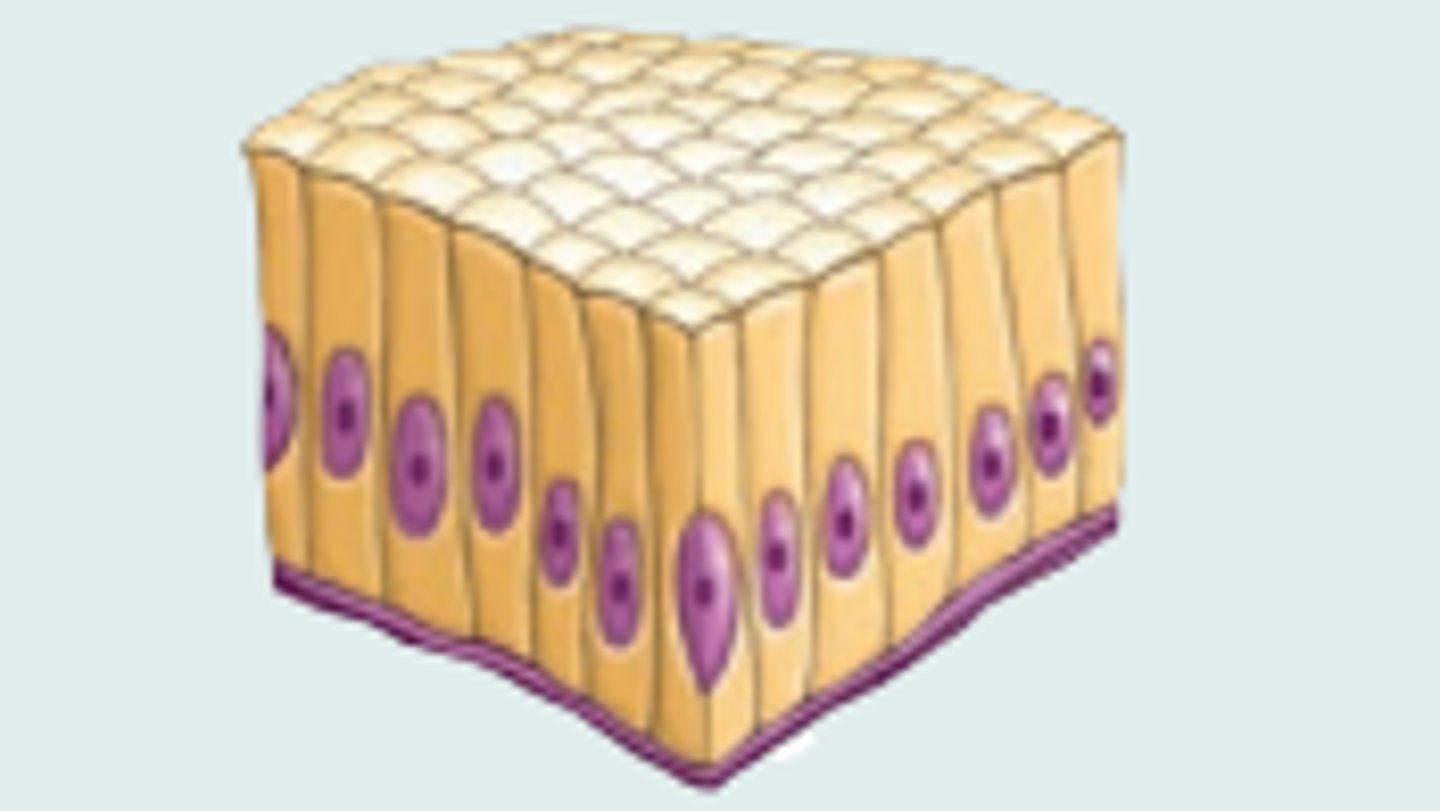
Pseudostratified Columnar Epithelium
Description: Stratified appearance but containing a single layer of cells of differing heights with nuclei at different levels; all cells are attached to the basement membrane, but some do not reach the apical surface; some tissue types contain ciliated cells and mucus-secreting goblet cells (unicellular glands).
Function: Secretion.
Location: Ciliated type lines the larynx, trachea, and large bronchi of the lungs; nonciliated type lines the male sperm-carrying ducts, and ducts of some glands

Stratified Squamous Epithelium
Description: Several cell layers; basal cells are cuboidal or columnar, and metabolically and mitotically active; surface cells are flattened (squamous).
Function: Protection from abrasion.
Location: Nonkeratinized type lines the oral cavity, pharynx, esophagus, and vagina; keratinized type forms the skin epidermis
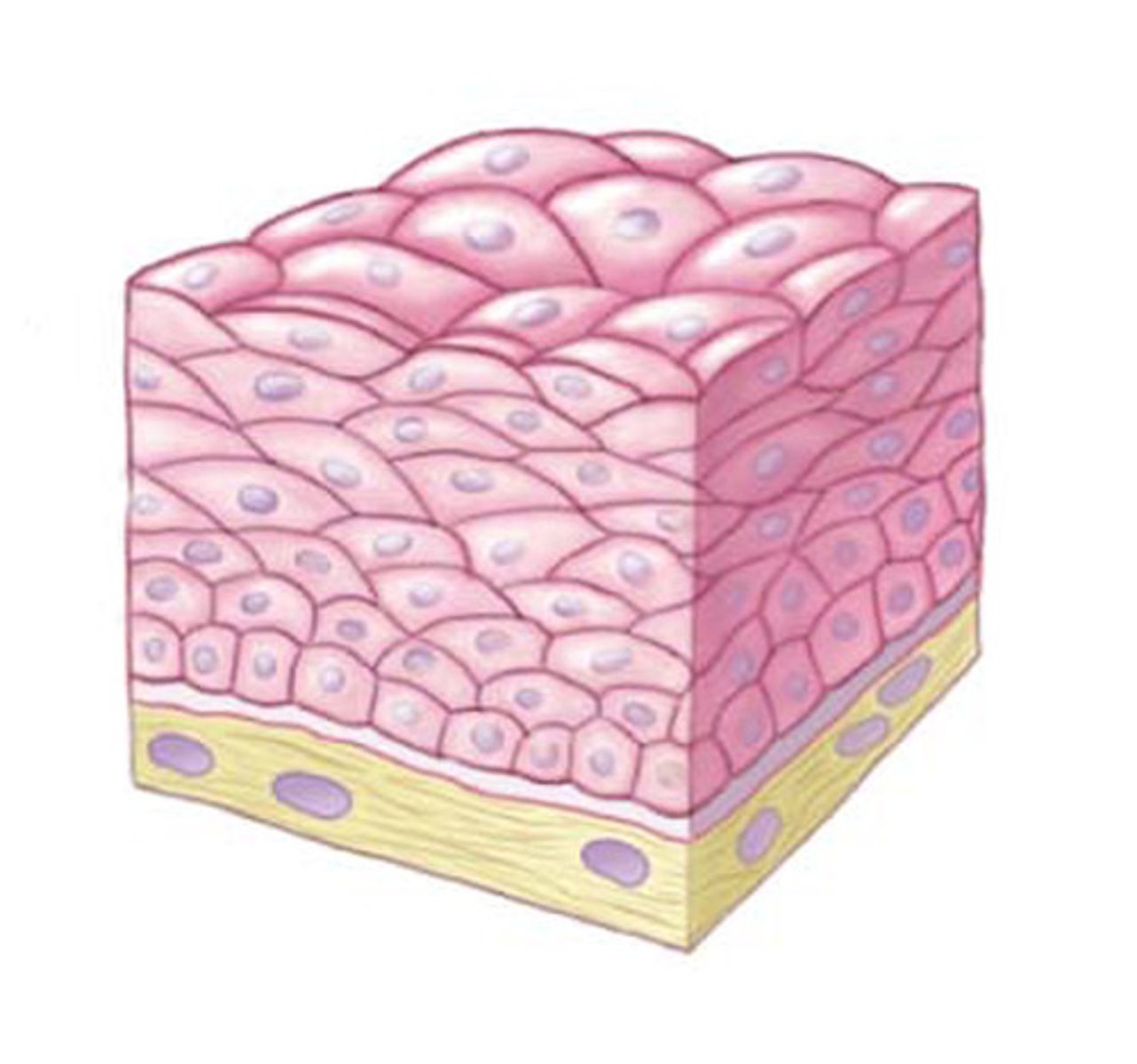
Stratified Cuboidal Epithelium
Description: Two or more layers of cells; the apical layer has cuboidal cells.
Function: Protection, secretion or absorption.
Location: Part of the male urethra, and ducts of glands, such as sweat, salivary and mammary glands
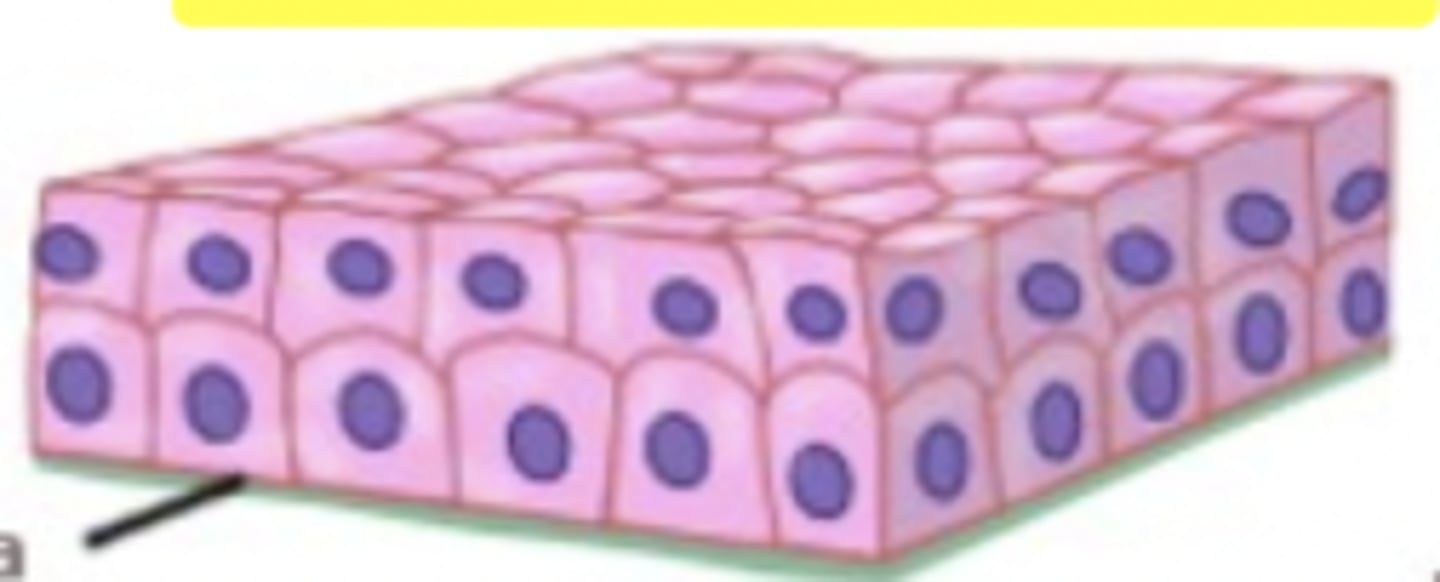
Stratified Columnar Epithelium
Description: Several layers of irregularly shaped cells; the apical layer has columnar cells.
Function: Protection and secretion.
Location: Large ducts of some glands, and lines part of the male urethra
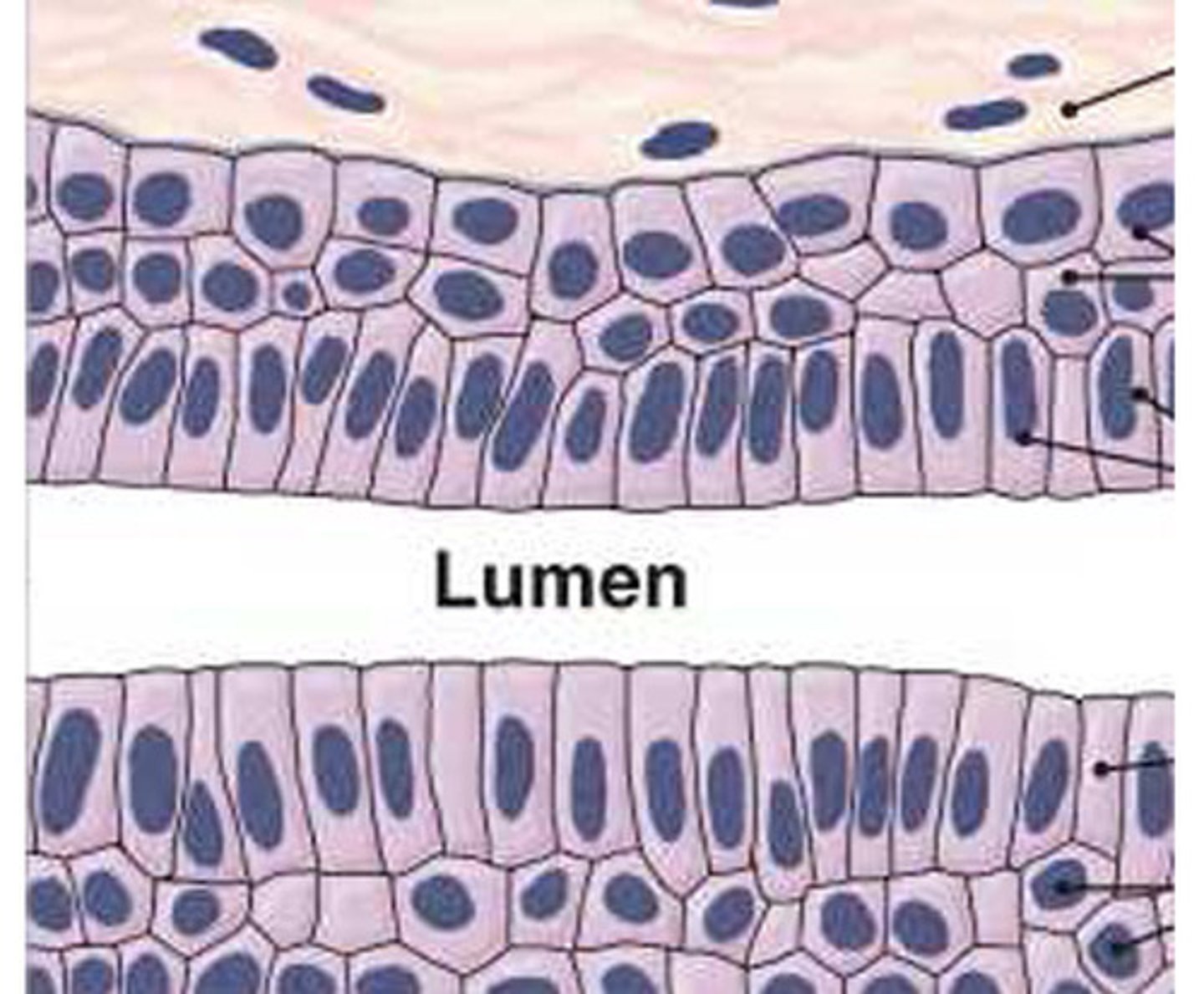
Transitional Epithelium
Description: Several cell layers that change shape when stretched; the basal cells are cuboidal or columnar; the surface cells are dome shaped or squamous like, depending on degree of organ stretch.
Function: Stretches and permits distension of urinary organs.
Location: Lines the urinary bladder, ureters, and the proximal urethra
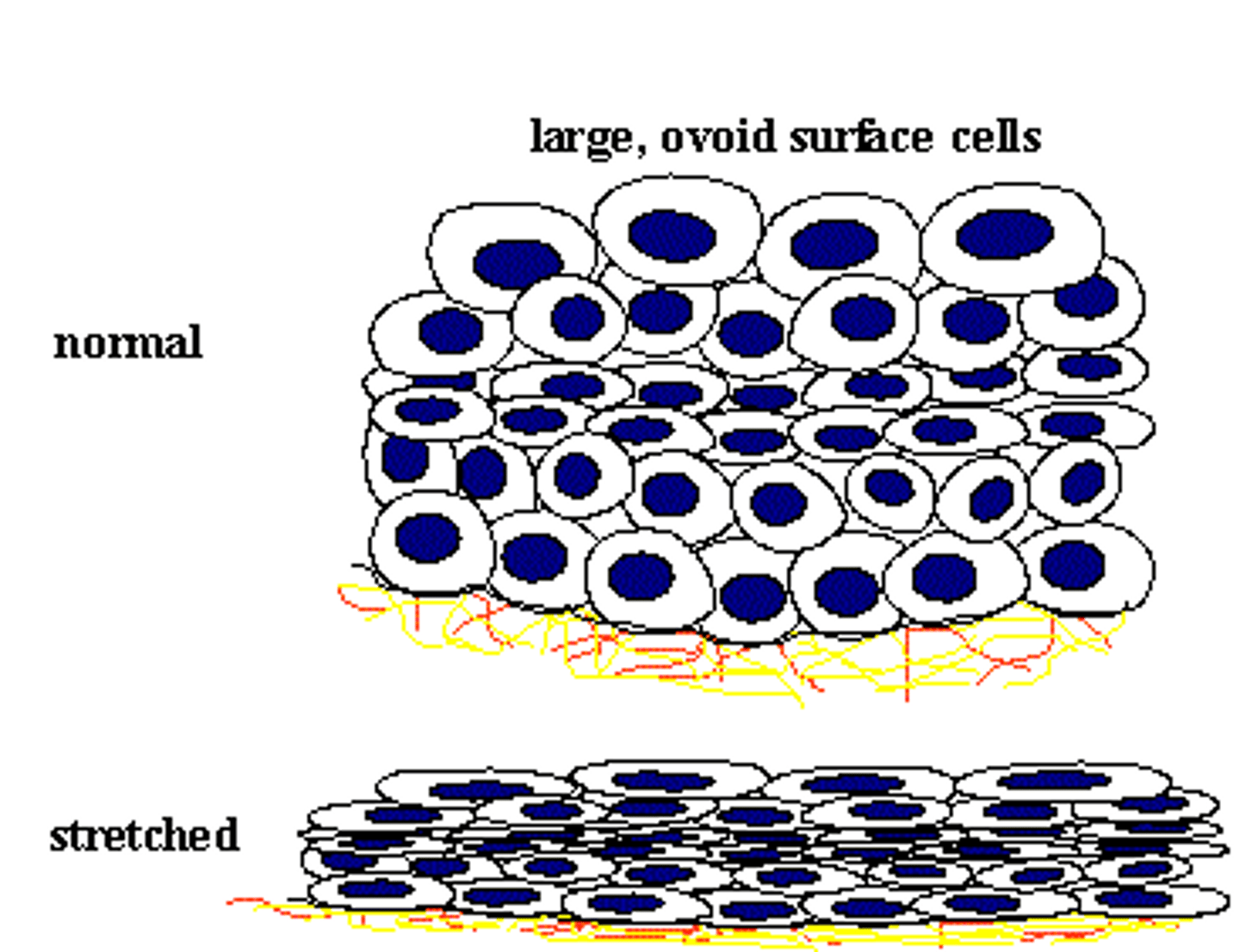
Glandular Epithelium: Endocrine Glands
Description: Secrete hormones that diffuse into the blood.
Function: Produce hormones that regulate body activities and maintain homeostasis.
Location: Examples include pituitary gland at base of brain, pineal gland in brain, thyroid and parathyroid glands near larynx (voice box), adrenal glands superior to kidneys, pancreas near stomach, ovaries in pelvic cavity, testes in scrotum, and thymus in thoracic cavity.
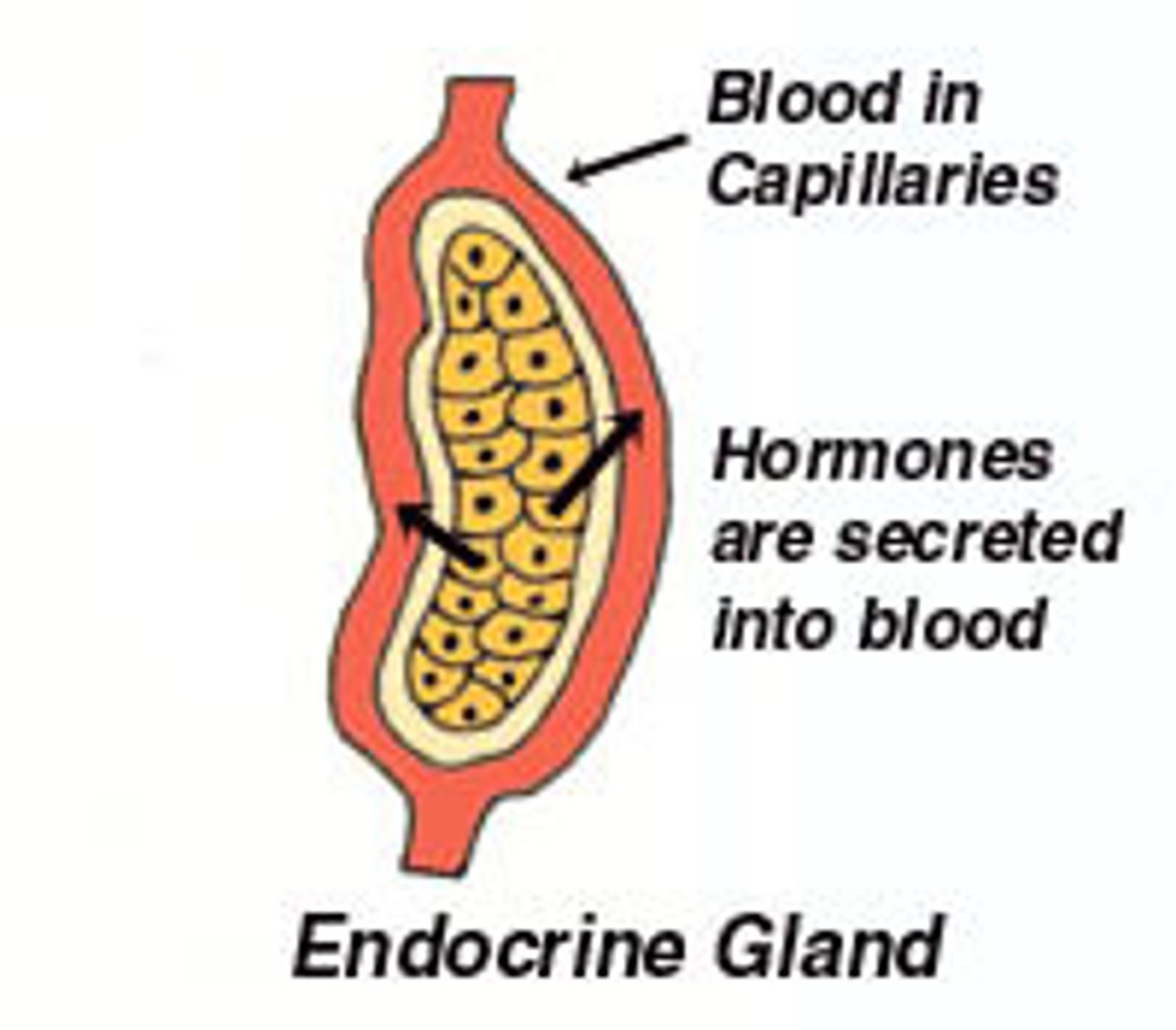
Glandular Epithelium: Exocrine Glands
Description: Secrete substances that are released into ducts.
Function: Produce and secrete substances such as sweat, oil, earwax, saliva, or digestive enzymes.
Location: Sweat, oil, and earwax glands of the skin; digestive glands such as salivary glands, which secrete into mouth cavity, and pancreatic glands, which secrete into the small intestine.
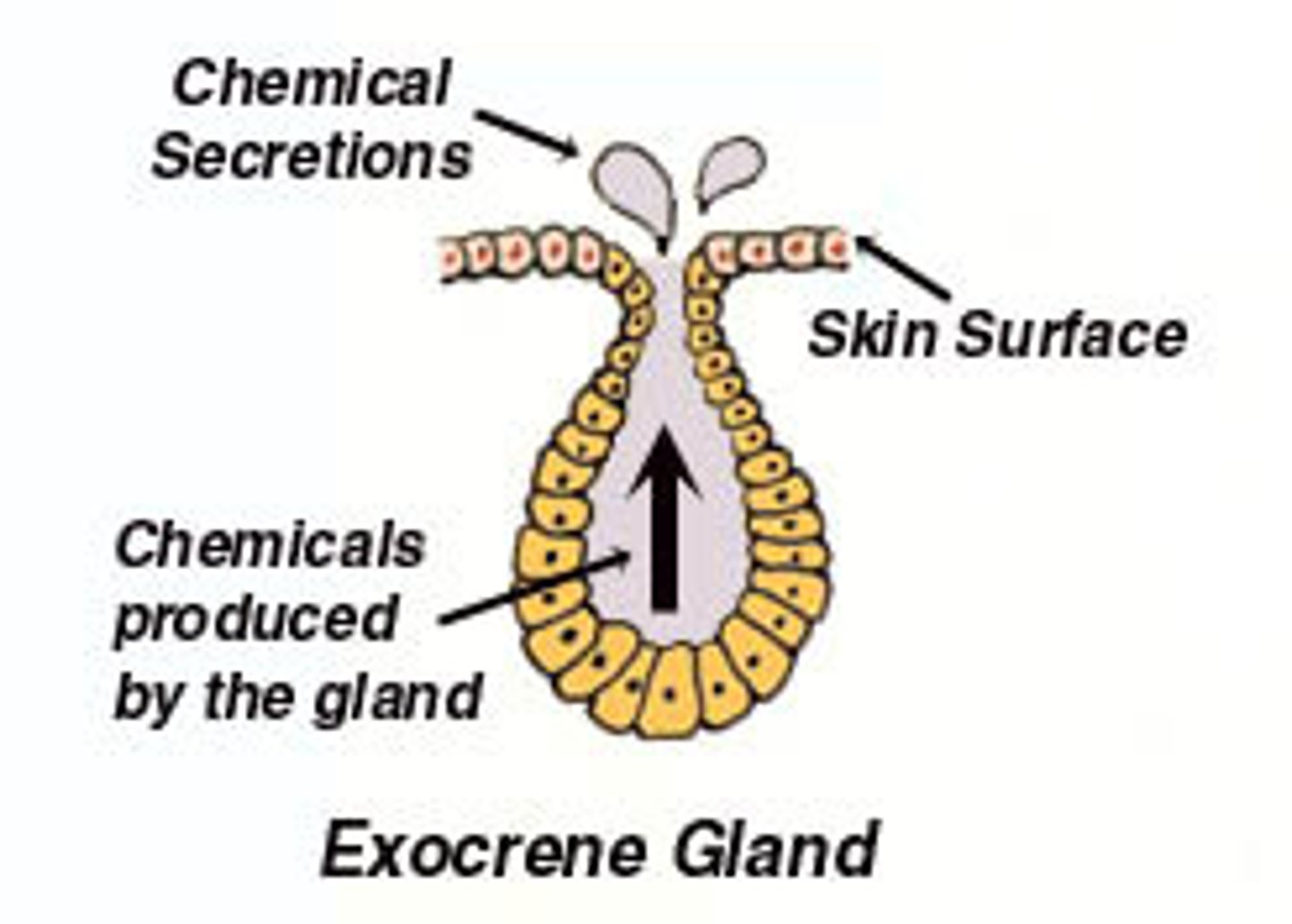
Mesenchyme
Description: Primordial embryonic connective tissue derived from mesoderm; consists of star-shaped mesenchymal cells in a gel-like ground substance with many fibers.
Function: Gives rise to all other connective tissue types.
Location: Primarily in the embryo and fetus
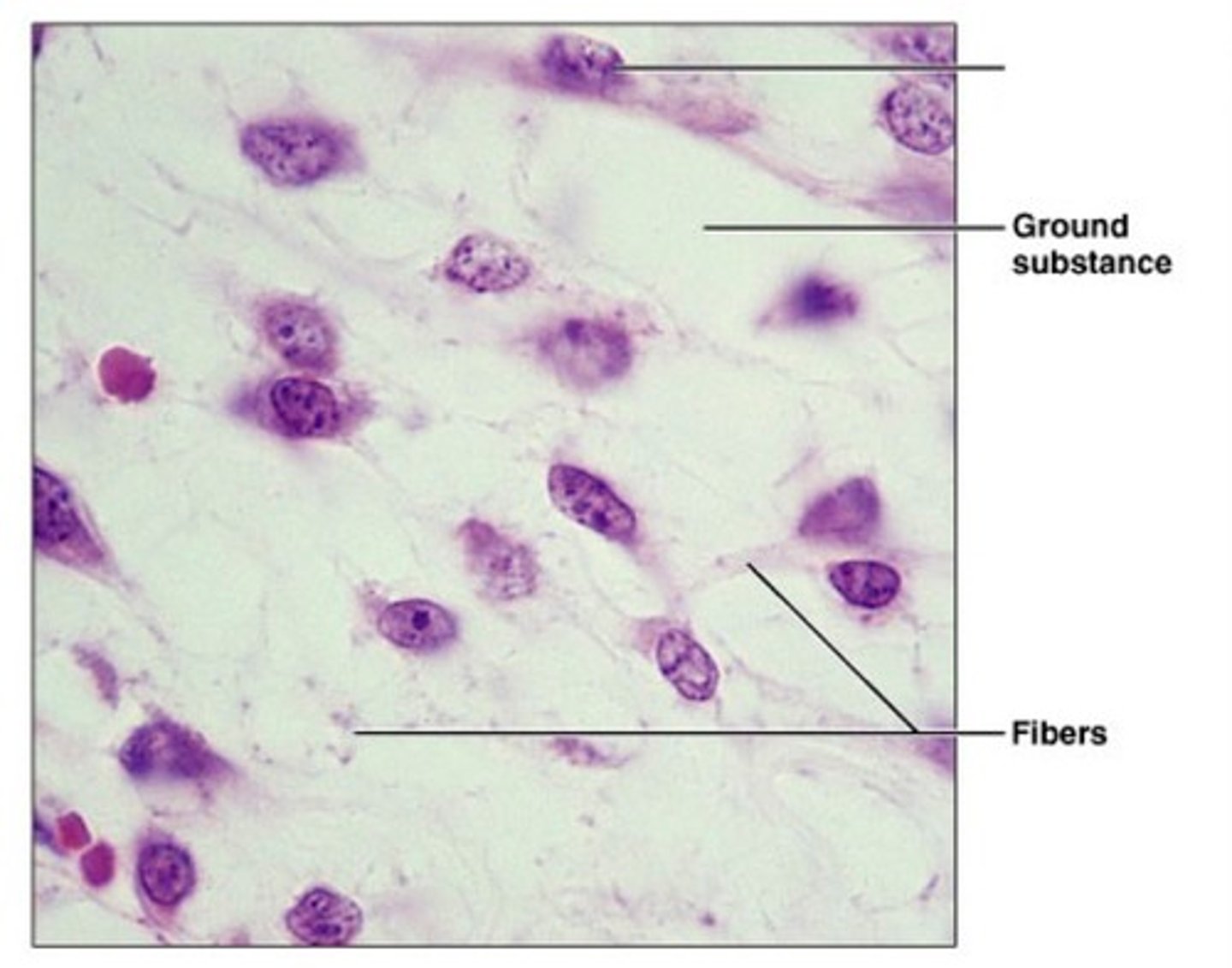
Areolar connective tissue
Description: Many different cell types in a gel-like matrix with protein fibers.
Function: Protection against disease; holds and conveys tissue fluid; wraps and cushions organs.
Location: Widely distributed under the basement membrane that is attached to epithelium; forms lamina propria of mucous membranes; surrounds capillaries and body organs.
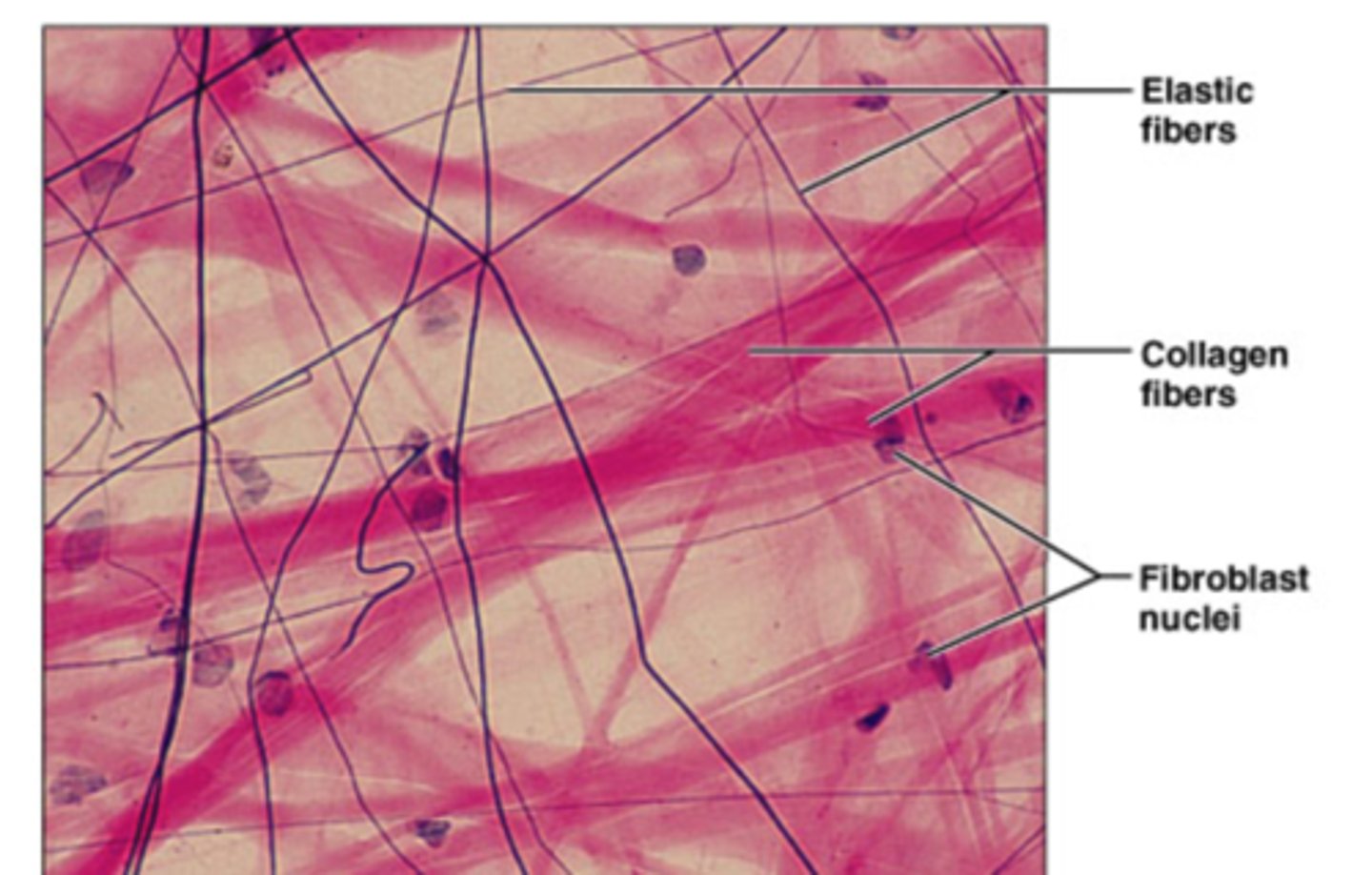
Adipose connective tissue
Description: Closely packed cells that have large central fat droplets and peripheral nuclei, and a sparse gel-like matrix with fibers.
Function: Provides an energy reserve, insulates against heat loss, supports and protects organs.
Location: Hypodermis under the skin, in breasts, around kidneys, behind eyeballs, and distributed as body fat.
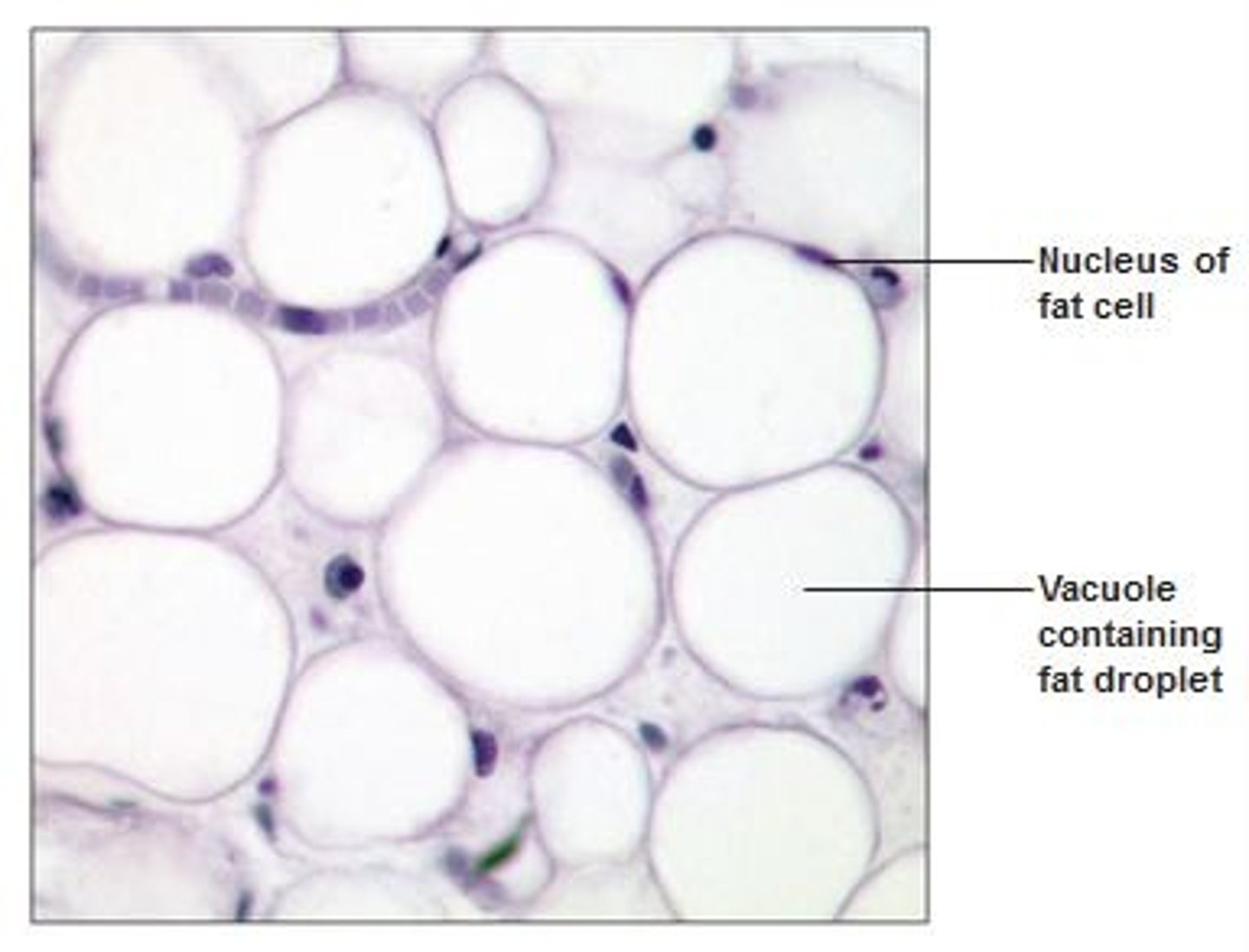
Reticular connective tissue
Description: Many cell types on a network of reticular fibers in a typical loose ground substance.
Function: Forms the internal skeleton (stroma) of organs, protects against disease, and removes worn-out cells.
Location: Lymphoid organs, such as lymph nodes, spleen, and bone marrow.

Dense Regular Connective Tissue (White Fibrous C.T.)
Description: Fibroblast cells, many parallel collagen fibers, some elastic fibers, and dense white matrix.
Function: Provides strong attachment of muscles and bones; withstands great tension exerted in one direction.
Location: Tendons, most ligaments, aponeuroses.
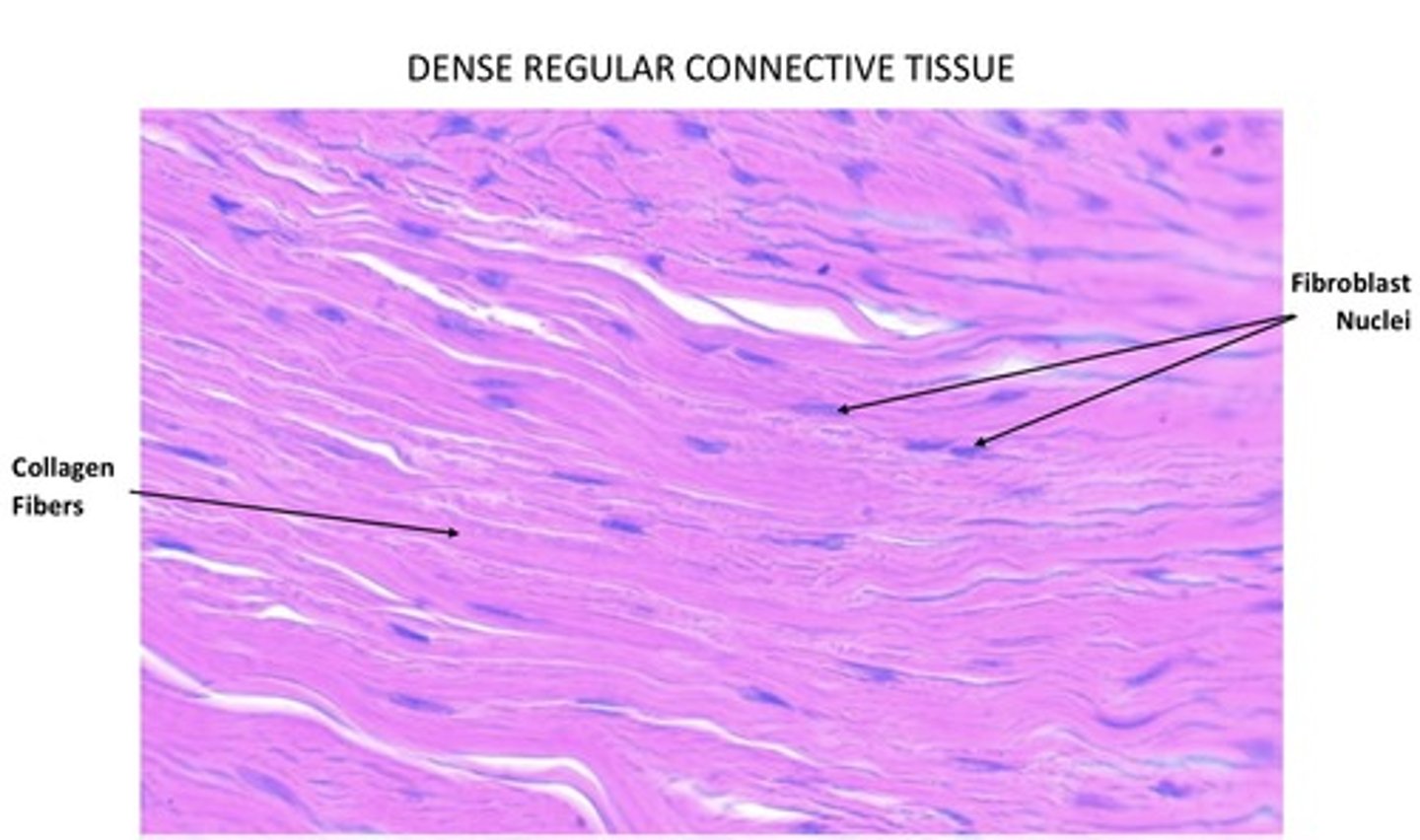
Dense Irregular Connective Tissue
Description: Fibroblast cells, many irregularly arranged collagen fibers and some elastic fibers.
Function: Provides structural strength, and withstands tension exerted in many directions.
Location: Most of the skin dermis, and capsules of organs and joints
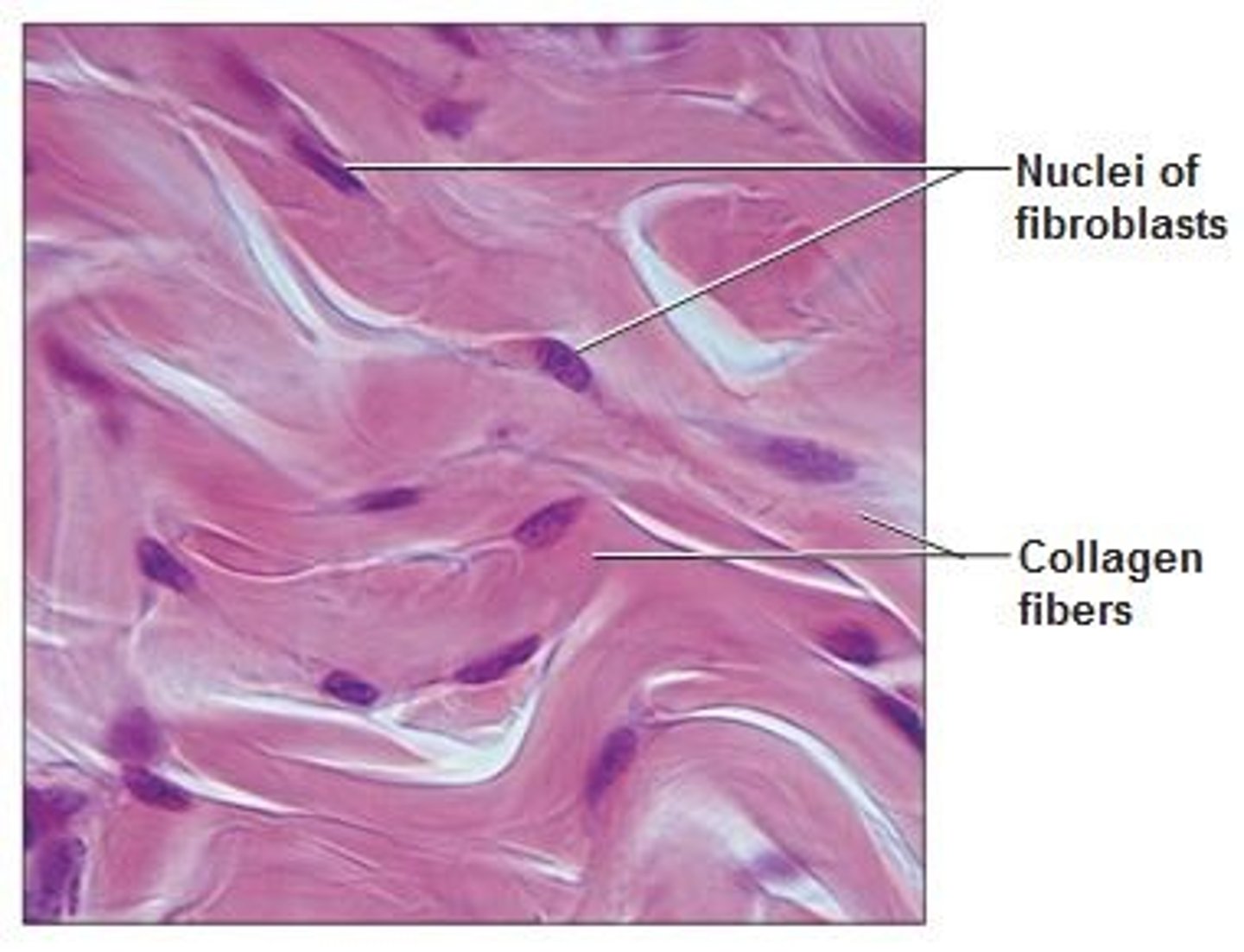
Elastic Connective Tissue
Description: Fibroblast cells, many elastic fibers and some collagen fibers.
Function: Allows stretching and passive recoil.
Location: Aorta and other large arteries; lung bronchi; some vertebral ligaments
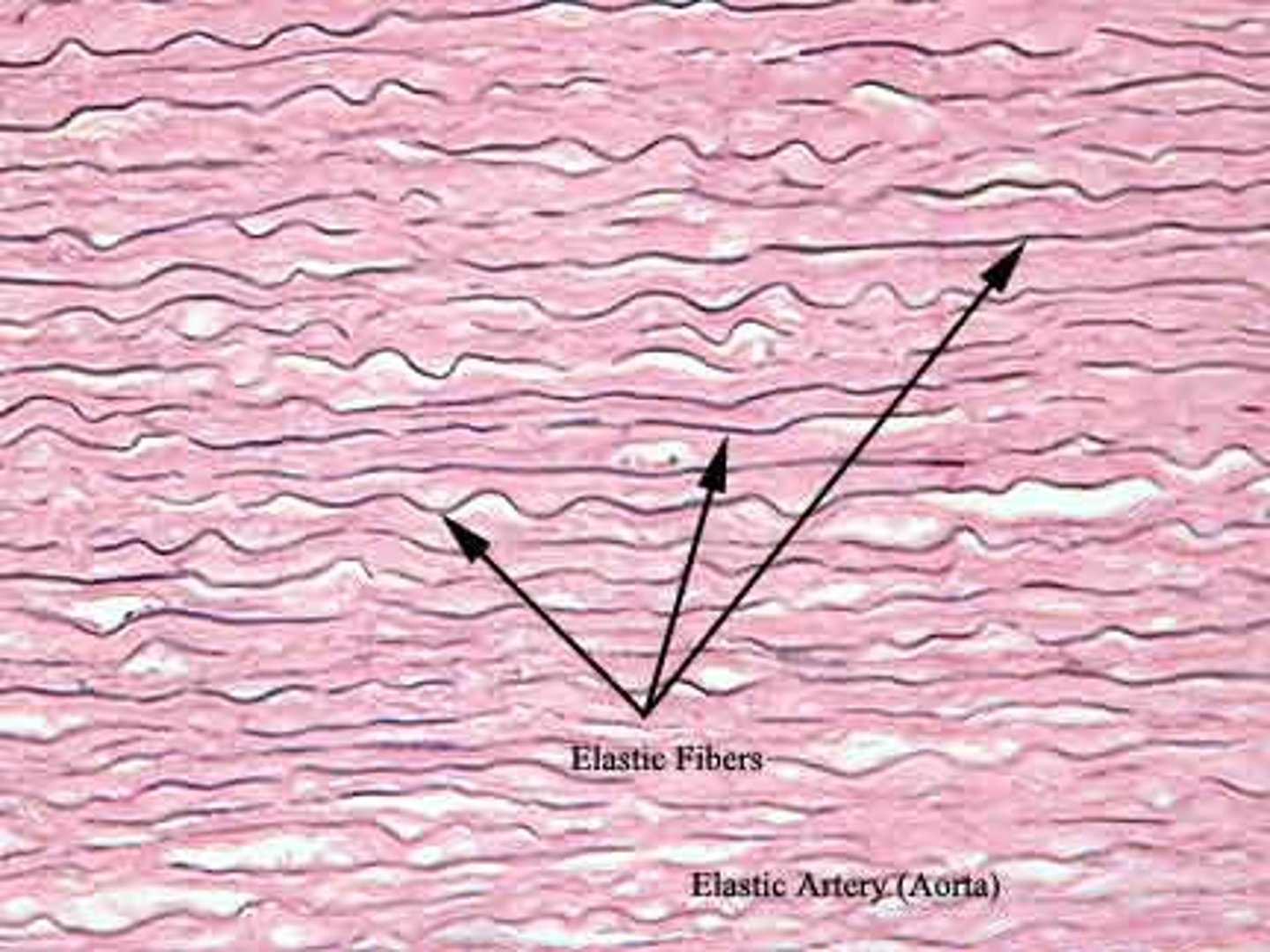
Hyaline Cartilage
Description: Many chondrocytes that lie in lacunae, amorphous but firm matrix, and thin collagen fibers.
Function: Provides support, flexibility, and smooth surfaces for joint movements.
Location: Cartilages of the trachea, larynx, and nose; costal cartilages of the ribs; articular cartilages of long bones; embryonic and fetal skeleton
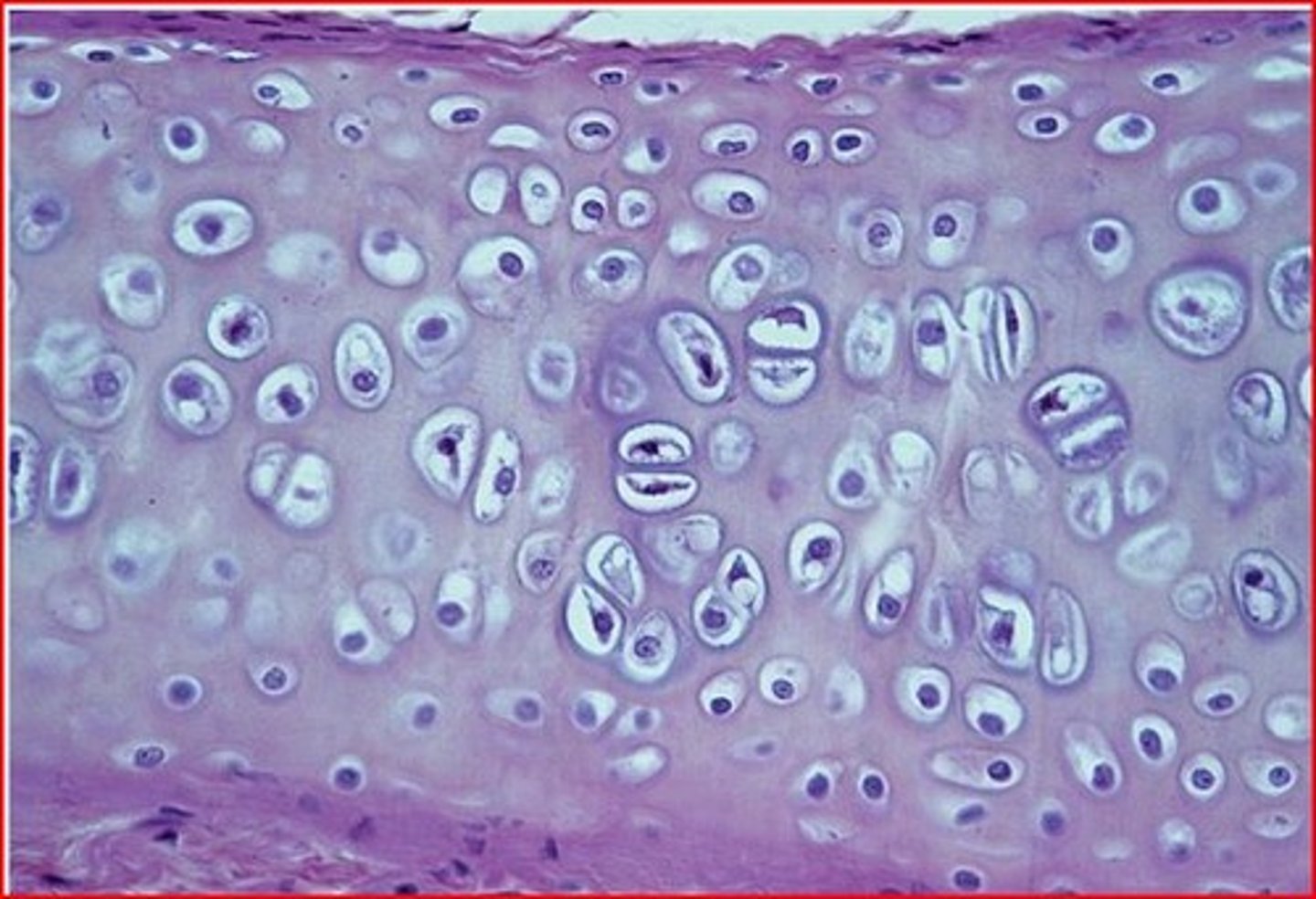
Elastic Cartilage
Description: Many chondrocytes that lie in lacunae, amorphous but firm matrix, and many elastic fibers.
Function: Provides support and great flexibility while maintaining shape.
Location: Ear auricle (pinna), and epiglottis.
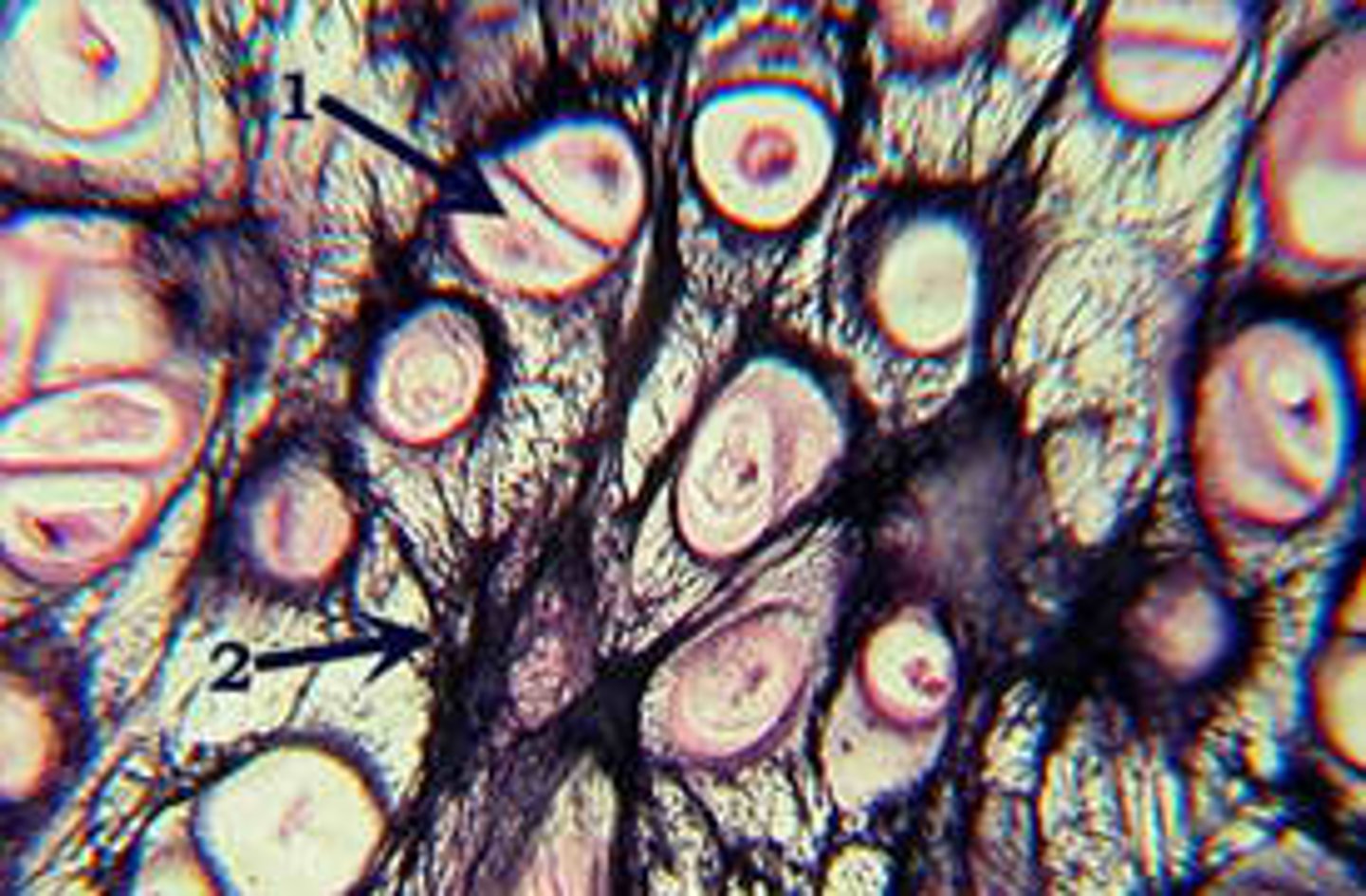
Fibrocartilage
Description: Many chondrocytes that lie in lacunae, amorphous but firm matrix, and many thick collagen fibers.
Function: Tensile strength with the ability to absorb compressive shock.
Location: Intervertebral discs, pubic symphysis, and menisci of the knee
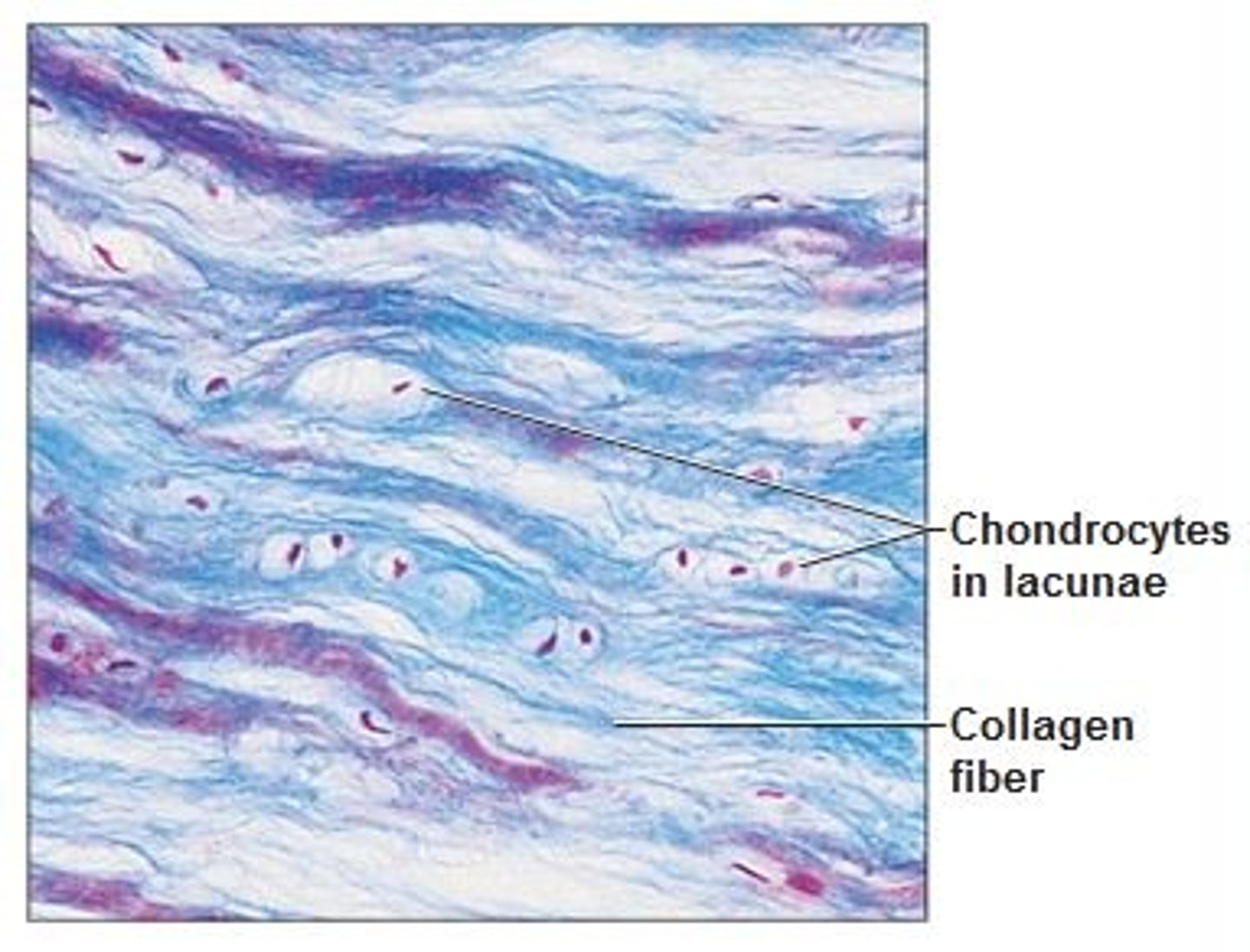
Bone (Osseous Tissue)
Description: Osteocytes that lie in lacunae, a hard calcified matrix, many collagen fibers, highly vascularized.
Function: Support and protection, provides levers for muscle action, and stores minerals.
Location: Bones.
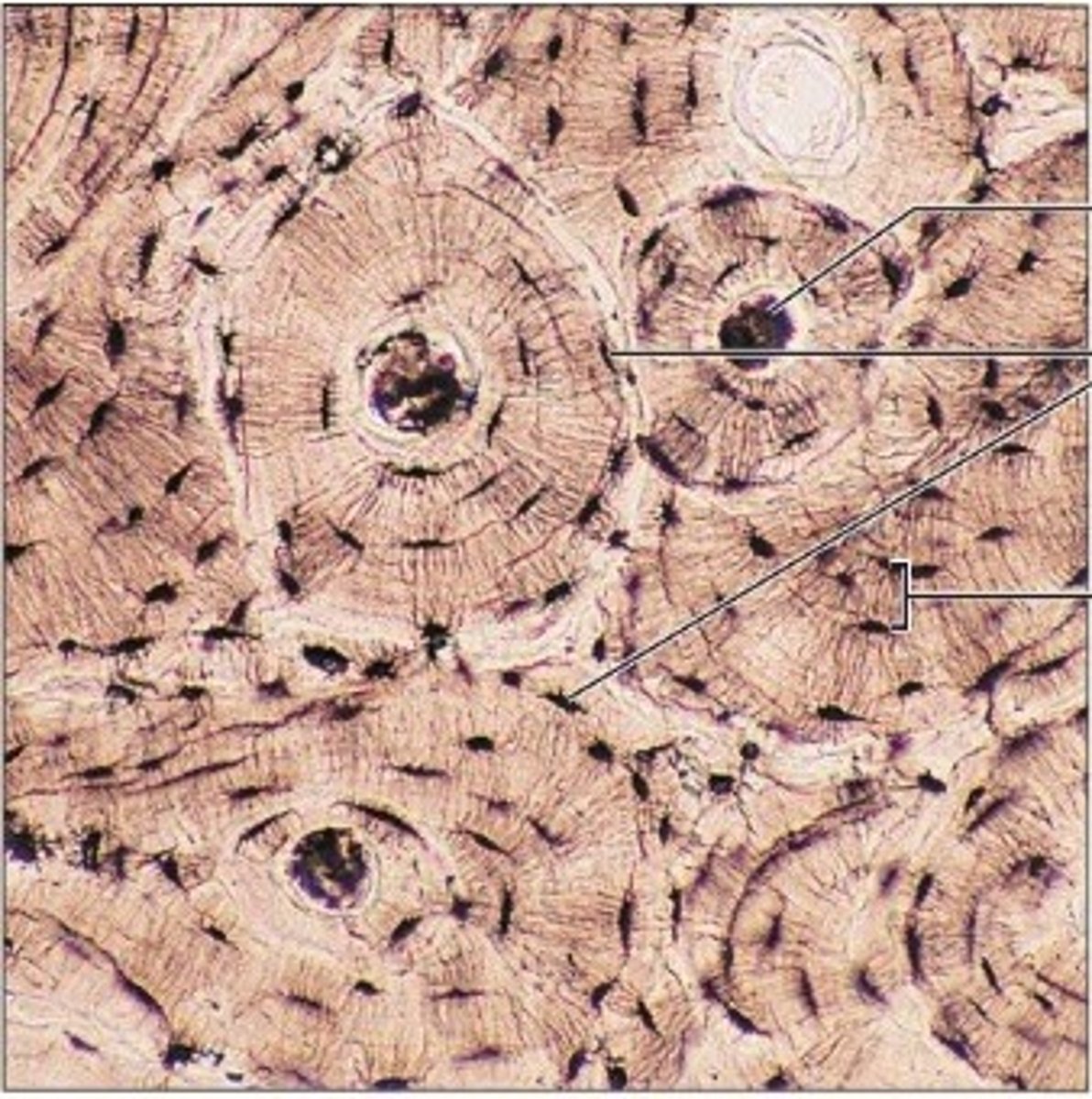
blood
Description: Red and white blood cells in a fluid matrix.
Function: Transport of respiratory gases, nutrients, wastes, and other substances.
Location: Within the heart and blood vessels
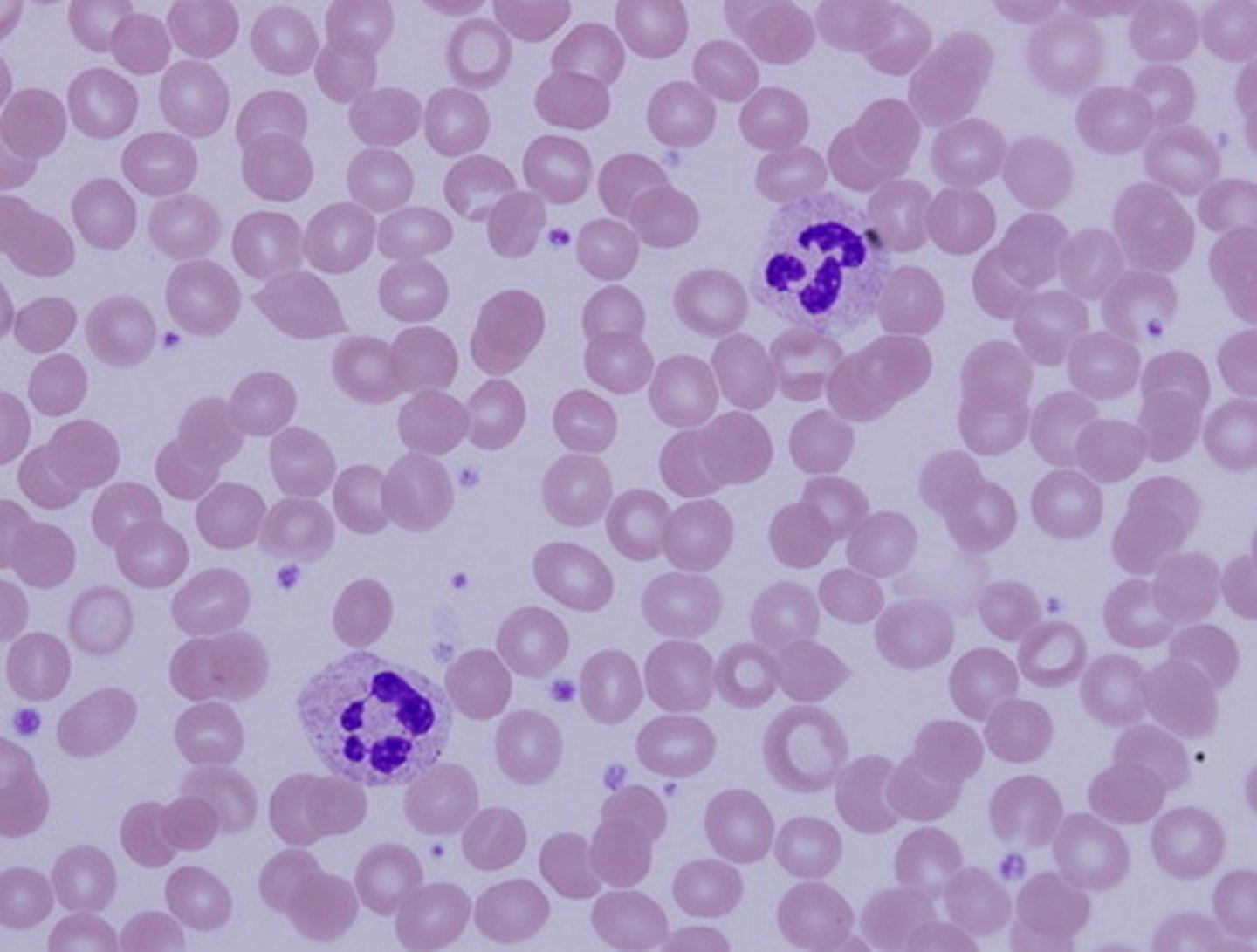
nervous tissue
Description: Neurons with cell processes extending from the nucleus-containing cell body, plus supporting cells called neuroglia.
Function: Transmit electrical signals from sensory receptors to effectors.
Location: Brain, spinal cord, and nerves
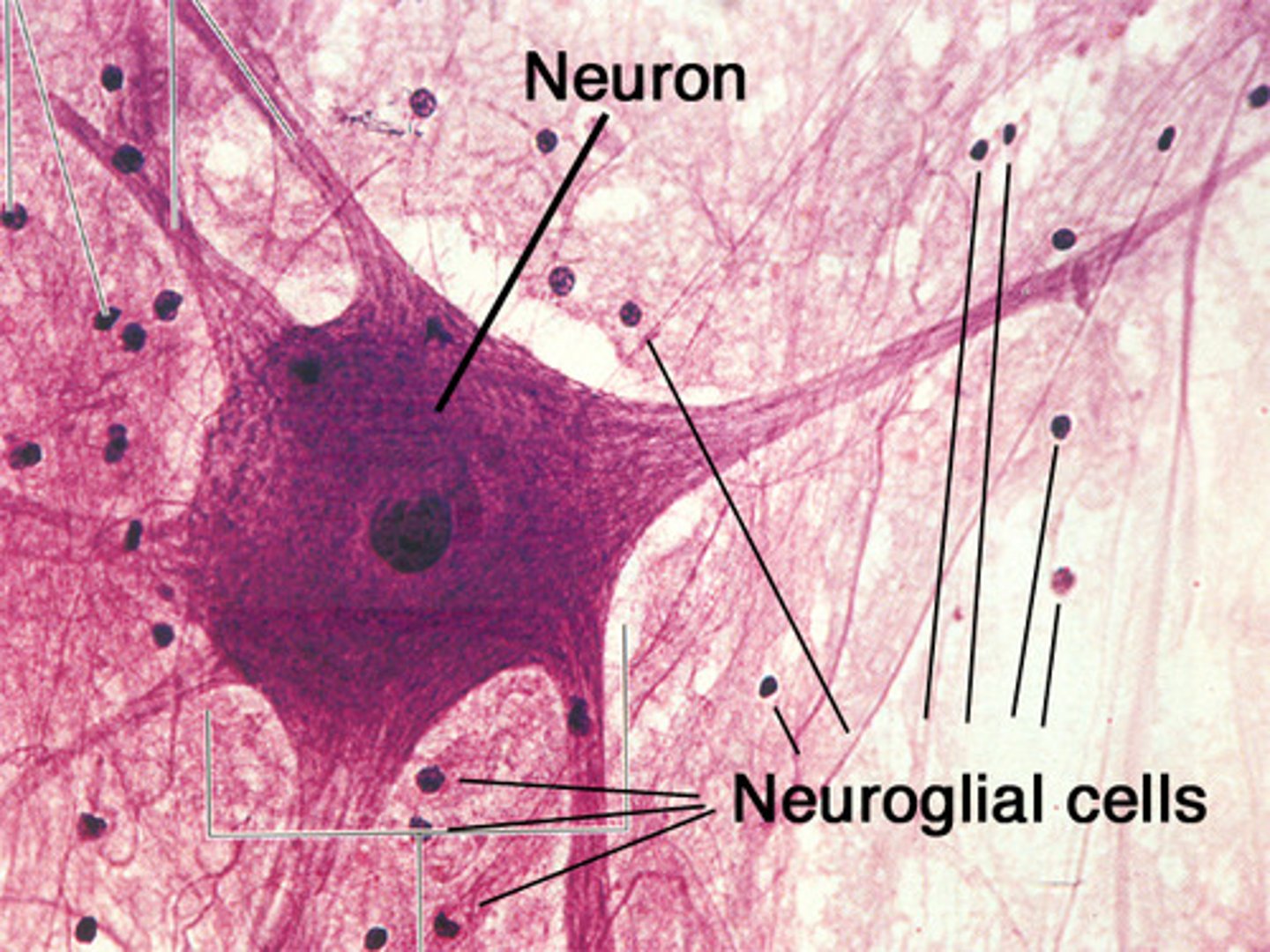
skeletal muscle tissue
Description: Long cylindrical cells that are multinucleate and striated.
Function: Voluntary movement; posture, protection, and heat production.
Location: Skeletal muscles.
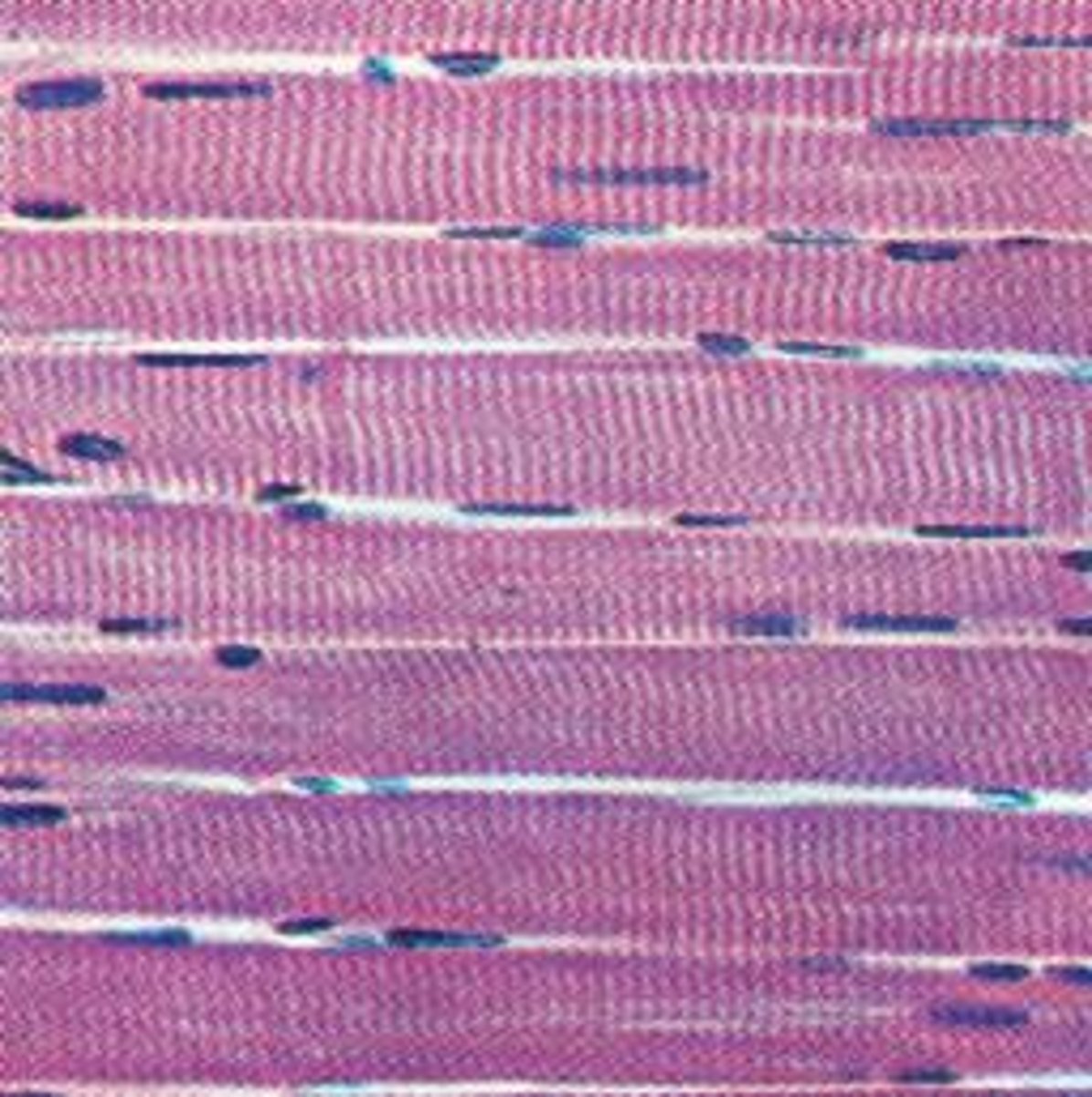
cardiac muscle tissue
Description: Branched cells that are striated, mostly uninucleate, and joined by dark staining intercalated discs.
Function: Pumps blood into the circulation under involuntary control.
Location: Heart.
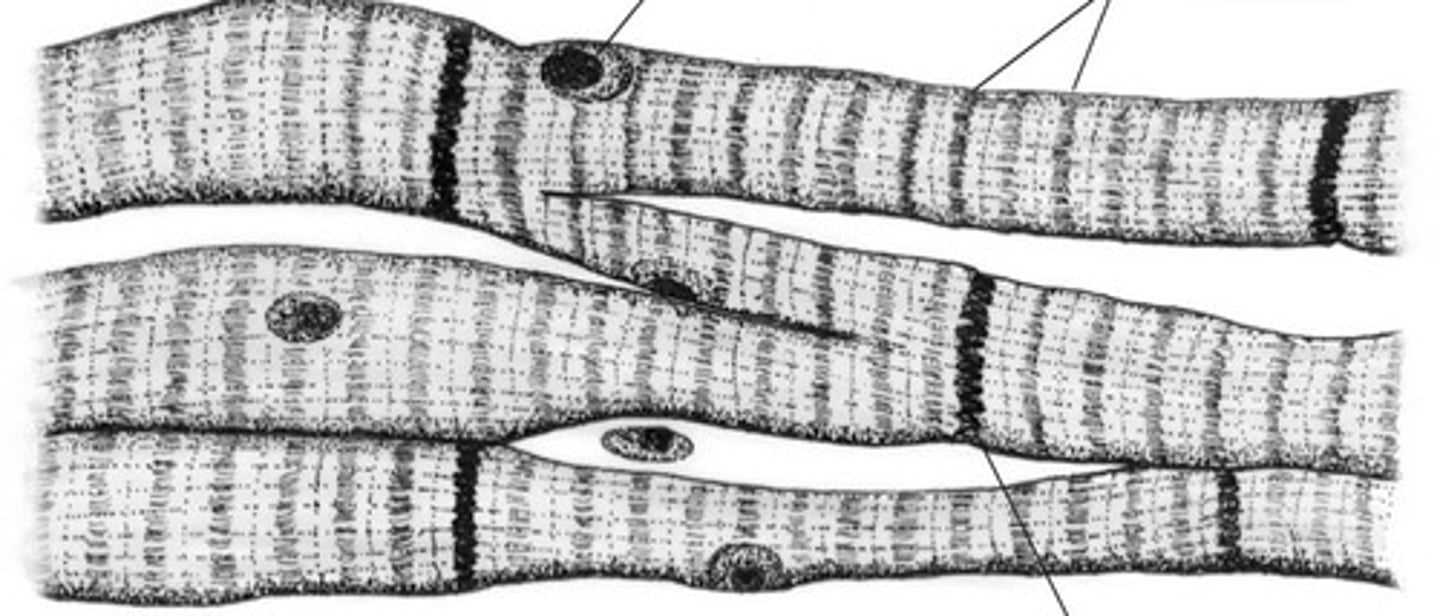
smooth muscle tissue
Description: Sheets of spindle-shaped cells that are uninucleate with no striations.
Function: Constricts, or propels material through hollow organs under involuntary control.
Location: Mostly in the walls of hollow organs.
